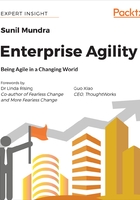
Build on emergence
In a dynamically changing environment, it is futile to try to predict the long-term future state accurately. Hence, rather than working backwards from an imaginary and inaccurate future state, it makes much more sense to work forwards based on the current state, which is known. Complexity implies that the end solution to a problem cannot be predicted at the outset. Moreover, the nature of the problem itself may undergo change, with a change in circumstances and the emergence of new information.
Not defining a future state should not mean lack of clarity about the goals and intended outcomes. However, the means to achieve the goals and outcomes must remain flexible. Hence, instead of having a detailed plan, which is supposed to show the exact way to get to the future state, a rolling plan should be prepared to ensure and maintain alignment with the broader intended goals and outcomes.
The plan should be detailed closer to current time, with progressive lower levels of details into the future. It is important to keep this as an organic element and to keep evolving this continuously, based on "today's reality." The plan should emphasize higher predictability in the near term and higher flexibility in the medium and long term.
The following diagram is a visual depiction of a rolling wave plan:

Figure 3.3: Rolling wave plan
In the preceding diagram, strategic product goals are defined for a longer period and the product objectives, functions, and work items are defined at progressive lower granularity, with the lowest granularity defined for work to be done closest to the current time.
The parts of a CAS cohere around common goals and hence the plan should clearly reflect the goals of the enterprise. Agents will self-organize in conducive conditions and do what it takes to achieve the goals. Building on emergence implies that the goals and outcomes may also need to undergo change, based on changes in the external environment. In such a case, the plan needs to change to reflect the revised goals and outcomes, and also the means to achieve the outcomes.
Another critical aspect of emergence is to work with "just enough" information. What is just enough is totally context-specific. However, it should be adequate to conform to an existing pattern or to form a new pattern. Seeing information as patterns is especially important as it is quite easy to get lost in data, which is available in abundance.
Information being valid for investigation and exploration should be the driver to guide the next steps. A practical example is the amount of time to travel from destination X to Y, by taxi. In terms of planning, it is good enough to know that it takes roughly 20-25 minutes for the journey. Knowing that it took 21 minutes and 33 seconds and 24 minutes and 10 seconds the past two times is valuable, but estimating to the last second for the next journey adds very little value.
Emergence also means that the enterprises have to be ready to deal with unforeseen circumstances, for example, customers venting their anger about a poor product or service on social media and its immediate and widespread negative impact is something which may not have been initially anticipated by companies. However, now that this behavior has become a pattern, businesses have no option but to put in a mechanism to spot such complaints and mitigate them as early as possible.